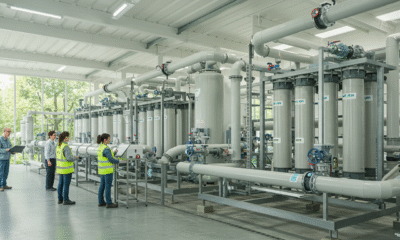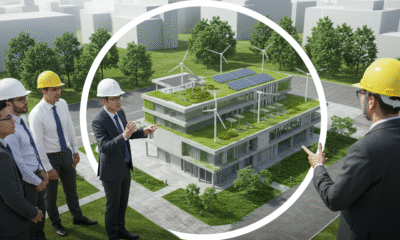In recent years, the focus on sustainable practices has dramatically increased across various sectors, particularly in commercial real estate. Around 80% of businesses have sustainability plans.
Companies are realizing that integrating renewable energy solutions is not only a cost-saving measure but also a powerful way to contribute to environmental sustainability.
According to recent industry reports, the shift toward green buildings and energy-efficient systems is reshaping the landscape of commercial real estate, aligning it with global climate goals and improving its appeal to environmentally-conscious investors and tenants. Green buildings use up to 30% less energy and can reduce their waste by 90%.
Websites like resustain.com have emerged as key resources, offering insights and tools to facilitate the transition toward sustainability in commercial spaces.
Why Renewable Energy Matters in Commercial Real Estate
Commercial real estate properties consume vast amounts of energy, often accounting for significant carbon emissions. Traditionally, most buildings rely heavily on fossil fuels, which contribute to greenhouse gas emissions.
However, renewable energy sources, such as solar, wind, and geothermal, present effective alternatives that reduce emissions while also enhancing the value and efficiency of real estate assets.
Integrating renewable energy in commercial real estate offers numerous benefits, including:
- Cost Savings: Lower utility bills from self-sustained energy sources.
- Environmental Impact: Significant reduction in carbon footprint.
- Market Appeal: Increased demand among tenants and buyers who prioritize eco-friendly properties.
- Government Incentives: Availability of tax breaks and rebates for properties using renewable energy.
These advantages make renewable energy not only an ethical choice but a strategic financial investment in commercial real estate.
Types of Renewable Energy for Commercial Properties
Commercial properties can leverage various forms of renewable energy, each with unique applications and benefits. Here are some of the most viable options:
1. Solar Energy
Solar energy remains one of the most popular renewable solutions for commercial real estate due to its accessibility and flexibility. Solar panels can be installed on rooftops or even used as building materials in facades, offering a dual-purpose benefit.
Notably, solar energy can help power lighting, heating, and cooling systems, significantly reducing reliance on grid electricity. With the addition of energy storage systems, excess energy can be saved for later use, enhancing the property’s resilience to energy shortages or outages.
2. Wind Energy
While more common in open and rural areas, wind energy is an effective solution for properties with adequate space.
Installing small-scale wind turbines can generate substantial electricity to power lighting, elevators, and other high-energy systems. Wind energy can be combined with other renewables, such as solar, to create hybrid systems that maximize efficiency.
3. Geothermal Energy
Geothermal energy is another promising solution for heating and cooling in commercial buildings. Geothermal systems leverage the consistent temperatures found below the earth’s surface to provide energy for HVAC systems. Although geothermal installations can have high upfront costs, they offer long-term savings and efficiency, especially in large commercial buildings with substantial heating and cooling needs.
4. Biomass
Biomass energy uses organic materials like wood, agricultural waste, or even specially grown crops to generate electricity or heat. For commercial real estate, biomass can offer a sustainable solution, particularly in industrial properties where high amounts of heat energy are required.
Financial and Regulatory Incentives
Governments worldwide are providing various financial incentives and tax benefits to encourage the adoption of renewable energy in commercial buildings. Programs such as the Investment Tax Credit (ITC) for solar energy and state-specific incentives for wind and geothermal energy make the shift more affordable.
Furthermore, regulatory bodies are setting stricter standards for energy consumption in commercial properties, making it essential for property owners to consider renewable energy solutions to comply with current and future regulations.
Adopting renewable energy can also increase a property’s score in green building certifications such as LEED (Leadership in Energy and Environmental Design) and BREEAM (Building Research Establishment Environmental Assessment Method), both of which are highly regarded in the real estate industry.
Enhancing Property Value and Marketability
As the real estate market becomes more competitive, renewable energy can provide a unique edge for commercial properties. Studies have shown that sustainable buildings with energy-efficient systems often attract higher occupancy rates and command premium rental or sales prices.
Prospective tenants and buyers are increasingly aware of the environmental impact of their choices and tend to favor properties that align with their values. This growing demand for green real estate makes renewable energy a valuable asset for property owners looking to boost their market appeal.
Boosting Long-term Investment Value
For investors, renewable energy represents a sustainable investment strategy with long-term benefits. Properties with renewable systems are better insulated against energy cost volatility, making them more attractive in the long run.
As the real estate sales and marketing trends toward eco-friendly solutions, investing in renewable energy can future-proof properties against shifting regulatory requirements and consumer expectations.
Conclusion
Incorporating renewable energy into commercial real estate is no longer a luxury but a necessity for property owners and investors committed to sustainability.
The transition to renewable sources like solar, wind, geothermal, and biomass not only reduces carbon emissions but also enhances the financial and market value of real estate properties.
By prioritizing eco-friendly infrastructure, commercial real estate can play a pivotal role in combating climate change and setting a standard for responsible property management.
The benefits extend beyond energy savings, creating a more sustainable, profitable, and appealing asset that meets the evolving demands of tenants and investors alike.


 Environment10 months ago
Environment10 months agoAre Polymer Banknotes: an Eco-Friendly Trend or a Groundswell?

 Environment11 months ago
Environment11 months agoEco-Friendly Home Improvements: Top 7 Upgrades for 2025

 Features9 months ago
Features9 months agoEco-Friendly Cryptocurrencies: Sustainable Investment Choices

 Features10 months ago
Features10 months agoEco-Friendly Crypto Traders Must Find the Right Exchange































